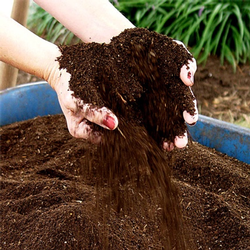Compost: Where & How to Use it
Compost is multi-purpose. It can be used as mulch, topdressing, soil amendment, or as an organic fertilizer.
How to use compost
To improve soil structure

• Apply a one-half inch to 3-inch layer of compost on garden beds at least once a year.
• Note: handle soil gently. The goal is to improve soil structure or tilth by encouraging microbial activity. The microbes create “glues” that bind humus and microscopic soil particles into larger units, leaving pore space for air and water, and thus encouraging and perpetuating a truly healthy, living, and fertile soil. Mechanical soil disturbance works against the building of soil tilth and microbial habitat, so keep disturbance to a minimum. Work soil only when moderately moist – not when wet. Don’t pulverize soil when working it. Avoid rototillers or other mechanical disturbance.
• Important: Some plants, especially California natives, prefer unamended soil and therefore may not appreciate an overabundance of compost. A 2-inch layer applied every two years may be enough. In some cases, using compost on native plants may actually be detrimental. In general, aim to match the needs of your plants with the quality of your soil.
As a seed starter
• Mix equal parts fine compost, sand and soil. The mixture should be fine in texture and should crumble easily when squeezed in your hand.
In a potting mix
• Use mature compost that is finely screened.
As a liquid fertilizer (compost tea)
• Compost tea is especially effective when setting out new plants.
Making compost tea
• Fill a bucket one-quarter full with compost
• Add water to fill the bucket.
• Stir the mixture repeatedly over 24 to 48 hours, the more frequently the better.
You may wish to use a small aquarium pump to keep air flowing through the mixture. Good, "active" compost tea needs to have air incorporated into it, so keep it stirred up and moving.
Using compost tea
• Dilute the mixture until it's the color of light tea.
• Pour 2 cups of this solution around the base of each plant.
• Larger plants can receive larger “doses.”
• Use up the tea mixture whenever you make it; it won’t keep its nutritional value when stored.
• Be wary of using too much in drought conditions. Fertilizing plants will encourage new growth, which then increases water needs to support that new growth.
Other uses
Although compost has been used for centuries in home gardening and commercial farming around the world, it has also become a more versatile and beneficial material. This includes:
• Erosion control
• Turf grass management and remediation
• Wetlands restoration
• Biofiltration for odor control
• Storm water runoff filtration
• Plant disease suppression in crop production and nursery industry
Where to use compost
Vegetable gardens
• Spring application: Spread one-half inch to 3 inches of compost over planting beds
• Fall application: If you plan to grow edibles in winter, apply at the same rate again
• Side dressing: During the growing season, compost can be applied around plants, taking care not to smother the crown areas of individual plants. The rate of application depends on:
• The existing fertility of your soil.
• The previous crop planted and how much the soil has been depleted.
• The nutritional need of the crop you will be planting.
Flower beds and borders
• Fine, well-decomposed compost is a boost to both annual and perennial flowers.
• Apply a 1-inch layer around existing flowers/shrubs.
Lawns
• After aerating the lawn in the spring, spread about one-half inch over the surface of the grass.
• Rake lightly to help work it down into the holes made by the aerator.
• Water in after application.
Trees and shrubs
• Moisten the ground around your trees and place a 1-inch layer of compost in a ring around the tree (one-half inch if the tree is growing in a lawn).
• Start the compost 2 feet away from the trunk of the tree and extend the compost to 1 foot beyond the drip line.
• Treat shrubs in the same manner, keeping the compost 6 to 12 inches from the base of the plant.
Houseplants
• Use the "seed starter" mix described above for potting indoor plants.
• Enrich your favorite potting mix by using three-quarters potting mix and one-quarter compost.
Containers
• Rejuvenate outdoor pots and planter boxes by applying a 1-inch layer of compost twice a year.
